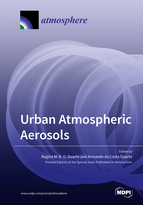Urban Atmospheric Aerosols: Sources, Analysis and Effects
A special issue of Atmosphere (ISSN 2073-4433). This special issue belongs to the section "Aerosols".
Deadline for manuscript submissions: closed (30 November 2019) | Viewed by 31324
Special Issue Editors
Interests: atmospheric organic aerosols; water-soluble organic aerosols; source signatures; health effects of organic aerosols; wet and dry deposition of organic aerosols; atmospheric stressors
Special Issues, Collections and Topics in MDPI journals
Interests: environmental and analytical chemistry; natural organic matter; nano- and microplastics; structural characterization; molecular tracers; chemical speciation; optical fiber sensors and nanosensors
Special Issues, Collections and Topics in MDPI journals
Special Issue Information
Dear Colleagues,
Atmospheric fine particulate matter (PM2.5, diameter less than 2.5 µm) has profound effects on radiative climate forcing, atmospheric chemistry, air quality and visibility, and human health. The PM2.5 can be directly emitted into the atmosphere (primary aerosols) or formed in the atmosphere by photochemical reactions of gaseous species (secondary aerosols). The physical and chemical characterization of PM2.5, its source apportionment, and the assessment of the magnitude and distribution of PM2.5 emissions is crucial in establishing effective fine air particles regulations and assessing the associated risks to human health.
Due to growing urbanization, urban areas are a very special case as far as PM2.5 concentrations, composition, sources, and health effects are concerned. The physical and chemical properties of urban PM2.5 (e.g., atmospheric concentration, size (fine- and ultrafine particles), surface area, chemical composition, and water-solubility) can influence the magnitude of adverse health effects. Therefore, it is highly desirable to conduct studies on the physico-chemical and toxicological characterization of urban PM2.5 in order to assess health effects and to establish efficient control strategies. Furthermore, understanding how urban aerosols affect the air quality of indoor environments in urban buildings is essential in assessing the potential health effects. Hence, much work is still needed to enhance our understanding of the chemical composition, size distribution, source apportionment, and indoor–outdoor relationships of PM2.5 in urban areas and their health consequences upon exposure.
In this Special Issue, manuscripts on all aspects of urban atmospheric aerosols, namely sources, analysis, and effects, are welcome.
Dr. Regina Duarte
Prof. Armando da Costa Duarte
Guest Editors
Manuscript Submission Information
Manuscripts should be submitted online at www.mdpi.com by registering and logging in to this website. Once you are registered, click here to go to the submission form. Manuscripts can be submitted until the deadline. All submissions that pass pre-check are peer-reviewed. Accepted papers will be published continuously in the journal (as soon as accepted) and will be listed together on the special issue website. Research articles, review articles as well as short communications are invited. For planned papers, a title and short abstract (about 100 words) can be sent to the Editorial Office for announcement on this website.
Submitted manuscripts should not have been published previously, nor be under consideration for publication elsewhere (except conference proceedings papers). All manuscripts are thoroughly refereed through a single-blind peer-review process. A guide for authors and other relevant information for submission of manuscripts is available on the Instructions for Authors page. Atmosphere is an international peer-reviewed open access monthly journal published by MDPI.
Please visit the Instructions for Authors page before submitting a manuscript. The Article Processing Charge (APC) for publication in this open access journal is 2400 CHF (Swiss Francs). Submitted papers should be well formatted and use good English. Authors may use MDPI's English editing service prior to publication or during author revisions.
Keywords
- urban atmospheric aerosols
- primary and secondary urban organic aerosols
- chemical composition
- toxic elements
- fine and ultrafine urban air particles
- urban emissions inventory
- urban air quality
- urban indoor air pollution
- health effects







